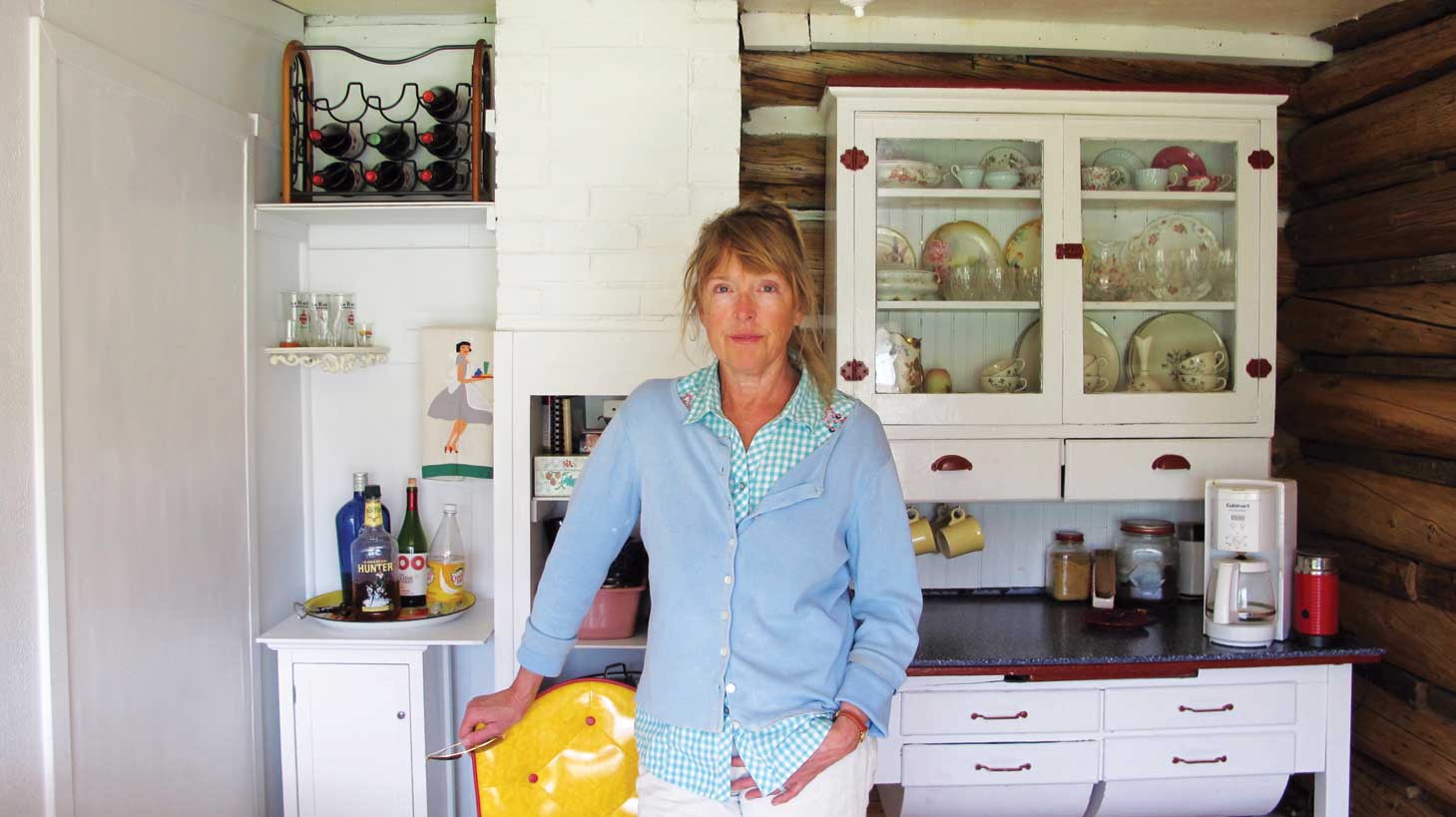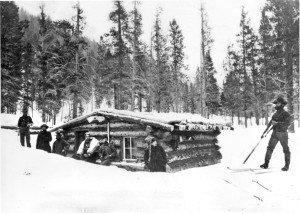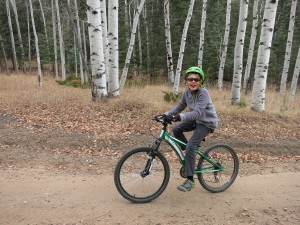by Charlotte Weiner
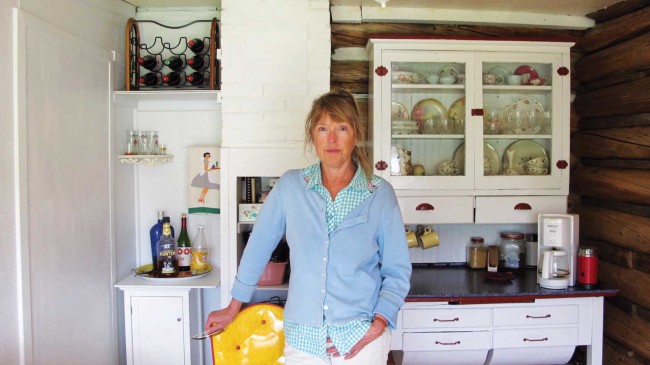
For rancher Kathleen Curry, the time for hollow reassurances is over. From her chair at the linoleum-topped kitchen table, she looks out to the view that a wide window frames: a small patch of lawn, a lattice of bleached wooden fence and beyond, hills that rise out of the flat plains, waves of green that fade to parched brown.
A low stretch of woods lines the hills’ base. “Out there,” Curry points a deeply tanned, delicate hand, “that’s the creek, right there, where those woods are.” She draws her gaze back inside. “It’s everything to us.”
Tomichi Creek, which flows into a tributary of the Colorado River, provides the water for the hay that Curry and her husband, Greg Peterson, a fourth-generation rancher, feed their cattle. But Curry says that her faith in maintaining rights to water from the creek is fading.
Once known as the American Nile, the Colorado is now diverted through fields and pumped to kitchen taps; it pools behind hundreds of dams, and flows through concrete channels until it narrows to a steady drip and dries up, miles from the sea into which it once flowed. Ranchers and farmers siphon water from the river for irrigation, while municipal and industrial forces pull water to fuel their cities’ growth. Recreationalists and environmentalists claim water for non-consumptive use, too.
While over three-quarters of the state’s water flows on the agricultural land of the Western Slope, over three quarters of Colorado’s population lives on the other side of the Continental Divide, on the Eastern Slope. Many of the cities and towns on the Eastern Slope are expanding rapidly, and the state’s population is on track to double by 2050.
This May was one of the wettest in recent memory in Colorado, but a shift toward warmer, drier temperatures across the Southwest threatens to further deplete the river. The Colorado relies on snowpack? – ?in its headwaters in the Rocky Mountains, and in peaks throughout the basin? – ?that melts and feeds the river. But this spring, the snowpack in Colorado was only two-thirds of its average size. The past fifteen years have seen the lowest average annual snowpack in a century. A 2011 Bureau of Reclamation report predicted that the river’s average annual flow will drop 8.5 percent in the next forty years; other projections cite up to a twenty percent drop, which would amount to a loss of over two million acre-feet of water.
[InContentAdTwo]
If climate change and growth continue on their projected course, Curry fears that the river system, already overstretched, will become wholly untenable.
With Denver and other cities growing so fast, Curry says, it is only a matter of time until mounting pressure on the river becomes too high. Curry believes that, in the municipalities’ search for water, “They’ll come to these ranches. And they’ll be met with shotguns.”
A few minutes later, the front door swings open and Peterson enters. In black jeans, with a wide-brimmed rancher’s hat pulled over his head, he leans through the doorway with the greeting, “Pleasure,” and enters the room.
He exchanges a few words with Curry, and they finish each other’s half-spoken sentences as he fills up an Ocean Spray cranberry juice bottle with water from the kitchen sink. They talk of returning phone calls, and a manure pile that still hasn’t been picked up. Soon, the door swings closed behind him.
“Everyone you talk to will tell you that the target is painted on the backs of people like Greg,” Curry says. She tucks a few stray strands of hay-colored hair behind her ear, steady, matter-of-fact. “This is the water that they think will save it.”
Curry wears a baby blue cardigan over a plaid button-up with a small, embroidered pattern of pink flowers near each shoulder. The softness of the outfit belies Curry herself. Her cheeks, nose and chin are a deep, warm tan; the dip below her brow, the shadow of her chin, and the pools beneath her eyes are almost pale.
Curry was born in Denver but traveled around when she was young. She lived in a different state every two years and went to college on the East Coast. She came back to Fort Collins for graduate school at Colorado State University, where she studied water resources. Curry served in the state legislature for years – ?where, she said, “sometimes, we wrote too many laws”?– ?but now spends most of her days ranching. Last year, Curry opened up a shop down the road in Gunnison where she sells beef from her ranch, among other local products.
The resort towns of Aspen and Crested Butte rise up in the mountains north of Gunnison, but the town lies low and is quietly, deeply beautiful. Patchwork hills with purple and yellow and blue wildflowers dust the valley, and a highway runs from Colorado Springs in the east, past Curry’s ranch and into Gunnison, and then out toward the desert in the west.
The ranch is a cluster of white and red worn buildings on the south side of the highway, just past mile marker 173. The family’s land, which Peterson’s parents bought over fifty years ago, covers 3,000 acres in all, and around 250 cows graze on the mountain hay that they grow.
“We’re tired of the lawyers saying, ‘Oh, don’t worry about it, honey, you’ll be fine,’” Curry says. “We won’t be fine.”
She spits out the word fine, and it drips with disillusion.
***
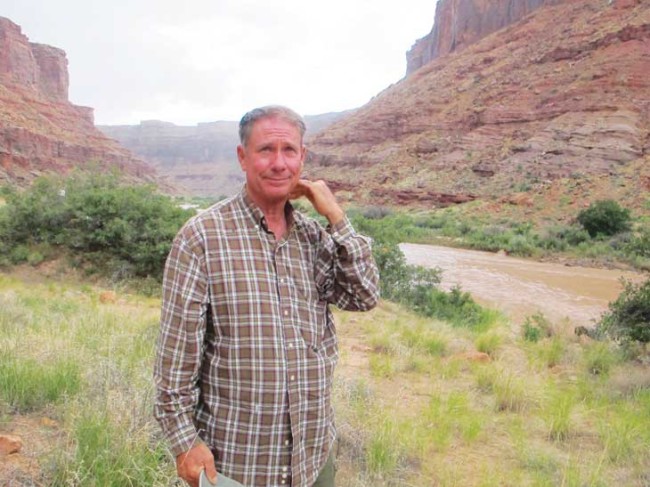
On a day in late November nearly a hundred years ago, eight men signed a document with the intention of settling the discord over rights to the Colorado River.
Instead, they set the course for today’s conflict over water in the West.
The Colorado River Compact, signed in 1922, divided the river among Arizona, California, Colorado, New Mexico, Nevada, Utah and Wyoming. The seven Southwestern states would use their allocated resources for beneficial, consumptive use? – ?agricultural and industrial development – ?and the river would, in turn, provide “all water necessary for the supply of any rights which may now exist.” The compact would “remove [the] causes of present and future controversies.”
But in the two decades that led up to the compact that formed the basis for allocation of the water, the Colorado’s average annual flow was, by some counts, higher than it had been in two thousand years. The signatories assumed that the river would provide nearly 18 million acre-feet of water to the states each year, and that extra would remain to maintain the river’s health. Since 1922, the Colorado has been, on average, over four million acre-feet shy of this number each year.
John Weisheit, a river guide and advocate who has been dubbed the “Colorado Riverkeeper,” described the misstep as tragic, in the literal sense: devastating and inevitable.
“We don’t understand our history. We have no understanding or respect for nature. But nature sets the rules,” Weisheit said. He was sitting in a café on the main street of Moab, Utah, a hundred and fifty miles west of Gunnison. A mile further west, the Colorado River slid lazily by.
Weisheit had ordered a bacon sandwich, which he would pick up at the end of a sentence, raise to his mouth as if to take a bite, and then set down on his plate again, and continue. He spoke with the slow, slightly bemused intonations of someone who is used to explaining things to others that appear to him quite obvious and straightforward.
Weisheit said that Colorado needs to temper its population growth, and that there should be a no-growth policy on new developments in Denver. He acknowledged that, when he proposes this, people accuse him of being “un-American.”
But a state study in 2010 reported what Weisheit and many others now cite as an unavoidable fact: Colorado’s population is on track to double, to 10 million, in the next forty years.
The men who signed off on the compact in 1922 did not anticipate growth of this scale, which is far from unique to Colorado. At the close of the twentieth century, the seven states in the Colorado River Basin comprised the region with the highest population growth rate in the nation.
“We need to conform to the limits of nature, but we won’t do it,” Weisheit said, setting down his sandwich again. “We don’t have the guts.”
Weisheit said, though, that unchecked population growth is only one of the sources of strain on the Colorado River system.
He described not only the immediate stresses on the river that human growth imposes, but also the long-term effects of climate change.
“The [Colorado’s] reservoirs are going empty, maybe not this year, but they are,” Weisheit said. “Even the people who have senior water rights? – so what? If there is no water in the reservoir, nobody gets anything. It doesn’t matter if you have a senior or junior water right. Everybody is going to lose.”
He tilted his head forward, and his short eyebrows gathered near his brow as he continued, unrelenting: “Pretty soon, we’re going to have no water, and no alternatives, and no backup, except for what falls out of the sky.”
A half hour later, Weisheit stepped out of his Highlander onto the red dirt on the river’s banks, just north of Moab. Clouds that hung over the red-rock cliff leeched away the morning heat, and as he talked, a storm rumbled in the distance.
It had rained the afternoon before, and the Colorado looked like coffee, milky and opaque. The sediment that filled the river stuck to the banks, and made a little beach to the left of where he stood. Below, the ground sloped away to the river below. Brambles and trees with silvery leaves rose up around him.
“I can tell you right now,” Weisheit said, looking up to the cliff face behind where he stood, “we are now twelve feet under water.” He pointed to a crop of driftwood on the slope behind him that marked where the river once flowed.
It is the variability of weather, the extremes – ?not only drought, but also floods? – that concern Weisheit. His advocacy group published a report last year that found that the river had flooded forty times in the last 2,000 years. They wrote that another flood of the same magnitude in the foreseeable future is far from impossible.
“You’re not supposed to see change in your lifetime, theoretically,” Weisheit said. “But I have.”
As the rain started coming down, Weisheit described how these afternoon rainstorms used to come a month or two later, in August or early September. Little rivulets traced paths through the sediment and flowed down the hillside into the river below.
By the time he got back to the car, the rain had turned to hail that cracked against the windshield. The windshield wipers pumped frenetically, and Weisheit looked around, a bit bemused. “Wow,” he mused. “This is real.” He fell silent as the hail clattered.
Soon, he broke the silence. “I’m going to keep on going, because in ten minutes there are going to be waterfalls crossing the highway. I’d just as soon get out of here as soon as possible.” And then, after a beat: “There’s a ten-minute delay on the rocks.”
A few minutes later, the burst had past. Weisheit leaned forward to check for dents on his windshield. He said, though, that it is this precipitation? – ?unreliable and sporadic? – ?that water users and managers are relying on. In some ways, too, it is what he is hoping will not come.
“The big fat El Niño could come this winter, and fill everybody back up all over again, and everybody would go, ‘Whew.’ That means it’s luck,” Weisheit said. “But luck is not a management plan.”
Next time there’s a drought, he said, there will be more people, more infrastructure, and less water.
“I swear to God,” Weisheit said, shaking his head as he flipped his wipers off. “It really is about praying for rain.”
***
On the banks of the Slate River, pools of water lie where a dirt road usually runs. “You want to get wet?” Jan Washburn asks and, without pausing, steps into the water.
Once she reaches the far end of the pools, Washburn can see the irrigation ditch that her great-great-grandparents dug. She speaks over the river, which rushes loud behind her. “This year, the writing was on the wall that it was going to be a drought, but it came,” Washburn says.
The “it” that Washburn describes is the late-season snow. This May, a hundred inches of snow fell on the mountains above her ranch. Earlier in the year, though, the mountains were practically bare. She and her extended family ranch thousands of acres near Crested Butte, Gunnison and Delta, and were preparing for a dry year, which last happened in 2012.
“It’s hard to picture right now, in all this rain,” Washburn said. “But my husband would take a shovel and dig holes in the water ponds, down, everyday, to see if he could find water for the cows to drink. All the water tanks we had out here?” She shakes her head. “The springs ran dry.”
While they had been preparing for drought, Washburn says she is also trying to adapt to the monsoons that have been coming earlier and earlier in the year. She harbors no uncertainty about the reason for this shift.
“I’m sure it’s climate change. We’re changing the whole weather pattern, when we’re getting our moisture,” Washburn says. “I think not acknowledging it is just keeping your head in the sand.”
Washburn said that the trees have started budding out in April, instead of mid-May. She grew up in this valley and said that, forty years ago, she would never see the wild turkeys, raccoons and foxes that she sees in today’s climate. “Anybody that spends significant time outside year-round should pick up on it,” Washburn said.
She counts herself, and her family, lucky for now. The spring was wet, her family’s holdings are diversified across the region, and the water rights on their land are some of the oldest? – and therefore most well-protected? – ?in the area. But she told me of a couple she knows who lives east of Colorado Springs, where the steady rains have stopped falling. Now, Washburn said, when it rains, all that grows there are tumbleweeds.
“When the wind blew, they had drifts that covered their home,” Washburn said. “Fifteen foot drifts of tumbleweeds.”
“And then there’s us,” she continued. “We’re doing okay.” But Washburn knows that, even if the rains continue, her water is under siege. “The eastern slope of Colorado would like to take our water. We’re the last untouched headwaters,” Washburn said. For now, though, “We’re holding on.”
A few miles downstream, the Slate flows into the East River. In a town called Almont, really just an outcropping of a few buildings, the East and the Taylor join to become the Gunnison River. It is the Gunnison that runs by Washburn’s father’s land, just outside of the town center in Gunnison.
Lee Spann, in a denim shirt and dark jeans, is reassuringly sturdy looking. He and Washburn have the same blue-jean colored eyes. His face, worn with creases, is a few shades lighter than the red-painted barn where he sits. Across from Lee is his grandson, Andy: same eyes, face smoother, almost polished-looking next to Lee.
“Twenty, thirty years ago, I would’ve said, ‘Sure, we’ll raise cattle here forever,’” Lee said. It was his great-grandparents who first settled near Crested Butte and carved the irrigation ditches in the land in 1878. They moved down to Gunnison in 1930 and raised Lee in the house next door, where he still lives.
Lee said that he never questioned going into ranching himself. But, now, he is unsure of whether he would have unhesitatingly encouraged his grandson to return to the family business. “I can’t answer that,” he says.
Here, Andy breaks in. He speaks at a pitch a few strains higher than his grandfather’s. “Our voice is strong right now, because there are people like my grandfather, and my dad’s generation,” he says. “But when we get to my generation, in this valley, it’s going to be tougher.”
While a cohort of ranchers in his father’s generation advocates for retaining their water rights, when that generation retires, Andy says, “There’s not going to be fifty guys. There are going to be five guys, standing in the corner.”
But when asked if, given the pressure, he would ever think about selling his water rights, Lee brings two fists down to the table in front of him with a thump of finality. His face contorts into what is almost a glare. “No. No. No,” he repeats. “Just a flat no. No.”
Andy asks, questioning: would we buy more? Lee leans back and nods, satisfied with his grandson’s prompt. “We’re not sellers. We’re buyers.”
Lee and Andy aren’t so worried about the rains not coming and weather patterns shifting, but a little later, when he starts talking about municipal growth, Lee backtracks. “We say, no, we never would sell,” he says, haltingly. “But we don’t know what will happen in the future.”
“When there are that many people that are dependent on the economic situation in the metro areas on the front range, and they contribute so much to the economy of the state and the nation,” his voice rises up; it’s almost a question. “I don’t know whether they’ll just overpower what we’re doing here.”
Andy tells me how, when he was a “little, little guy,” his father? – ?Washburn’s brother? – spent several years battling the diversion of water out of the valley to the Eastern Slope. The lawsuit ended five years ago, and they still retain their water rights.
“At some point, it’s going to happen again. There will be a different lawsuit,” Andy says. “They have the money. Are they going to let the people go thirsty, or not shower, in Denver? Or are they going to come get our water?”
***
The CEO of Denver Water wears a button-down tucked into pants that neatly crease across the top and down the knee. Two thick gold bands circle each of his ring fingers. He speaks in the well-practiced cadences of a CEO, in fully formed paragraphs, but he peppers his sentences with the word “frankly,” an assurance of transparency that does not come off as empty.
Jim Lochhead tells me that, “certainly,” Denver is going to grow. Denver Water currently serves 1.3 million people in Denver and its suburbs, approximately a quarter of Colorado’s residents. The Board’s net position at last year’s close was over $1.8 billion dollars.
Lochhead says that his company’s revenue fell significantly this year because of the above-average precipitation in the late spring. Usually, though, only fifteen inches of rain fall in Denver each year – ?the same as Los Angeles, and only a quarter of what Miami receives.
But after six years of negotiations with agricultural workers on the Western Slope, Lochhead signed the Colorado Cooperative Agreement, which includes a pledge to halt any plans for future transmountain diversions to the Eastern Slope municipalities. He says, too, that he holds no intention to buy off ranchers’ water rights and force their land to dry up.
“Denver’s modus operandi for decades was simply to go out and grab water without regard for the impact on the local community,” Lochhead says. “That made Denver Water a reviled entity on the Western Slope.” Now, Lochhead says he is trying to work with the ranchers and farmers. He added, though, that many are reluctant to make any move toward willingly reconsidering water redistribution.
“We need to move past the parochial attitude and the defensiveness,” Lochhead says. “There are lots of people who don’t want to do anything because they’re afraid that they might get hurt by change. But they know that they’re going to get hurt by the status quo. That’s what is –” Here, he pauses his stream of speech, and looks up, a bit beseeching. “It’s what, I guess, I struggle with.”
He insists that there is “sufficient” water in the West to satisfy both agricultural and municipal demands, as well as to placate recreationalists and environmentalists. But Lochhead concedes that reforming water policy is far from straightforward.
“The regulatory hurdles that need to be overcome to do anything proactive are just so enormous, and the transaction costs are so high, and the risks are so high, that everybody is driven to the lowest common denominator, which is simply buying out agriculture,” Lochhead says.
Beyond the multiplying numbers of municipal residents, Lochhead points to environmental change as a driver of his company’s need to secure more water for their customers. “It’s frankly irresponsible if we don’t plan for climate change,” Lochhead says.
He is pushing for measures that would increase efficiency, including legalizing the collection of rainwater runoff.
“To me, frankly, it doesn’t make sense for us not to maximize the efficiency of the water that is, essentially, falling from the sky on us, before we go far afield to go and find water, and take it from someone else,” he says.
But, even with moves toward increased efficiency promised, his language makes clear that the status quo? – ?to go and take others’ water – is not far from the present reality.
***
Curry believes that the conflict between municipal demands and agricultural use is “not a matter of if. It’s a matter of when.” In her kitchen in Gunnison, she runs her hands through her hair, and fixes her eyes on the edge of the table in front of her. Her eyes have turned red-rimmed.
“How long can we hold on? If they’re short, they have the numbers, and the money,” she says. “We’ll do everything we can, and just keep plugging, keep raising cattle. But I don’t know, if you came back 25 years from now, if you would see productive land, especially with climate change.”
If anyone attempts to claim her water rights, Curry will sue, and go to court if needed. She says that she will do anything in her power to remain on the ranch, to maintain her rights to the water in the river. “It’s our lifeblood. It’s the blood that feeds the entire community,” Curry says.
She glances up, briefly, and then her eyes return to where they rest on the trees that line Tomichi Creek, and the river beyond. “I wouldn’t have married a rancher, and lived here, and spent my entire life working in water, if it wasn’t my first love.”
This article was produced with support from The GroundTruth Project.
Charlotte Weiner is an Ethics, Politics and Economics major at Yale University. She is the managing editor of the weekly newspaper The Yale Herald, captains the club soccer team, and leads outdoor hiking trips for freshmen. As a fellow for The GroundTruth Project, she reported on youth unemployment and climate change. Her favorite word is aplomb.

